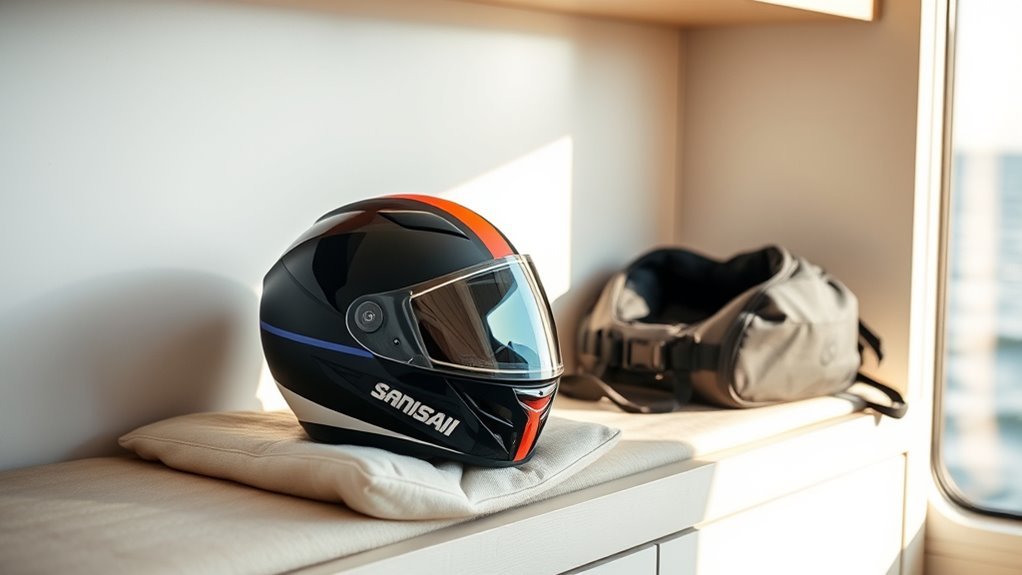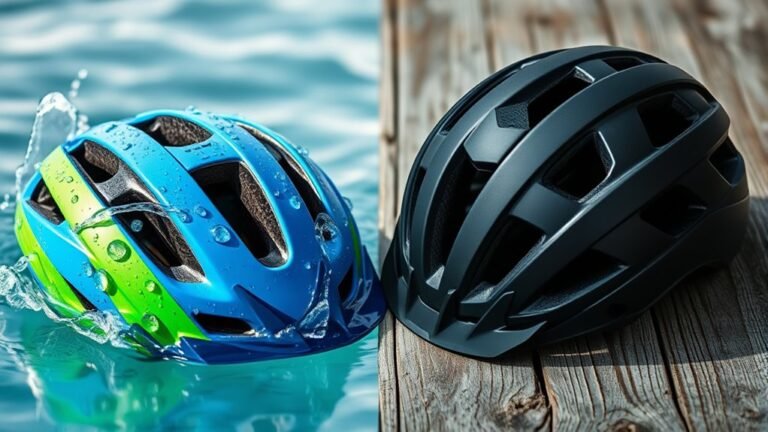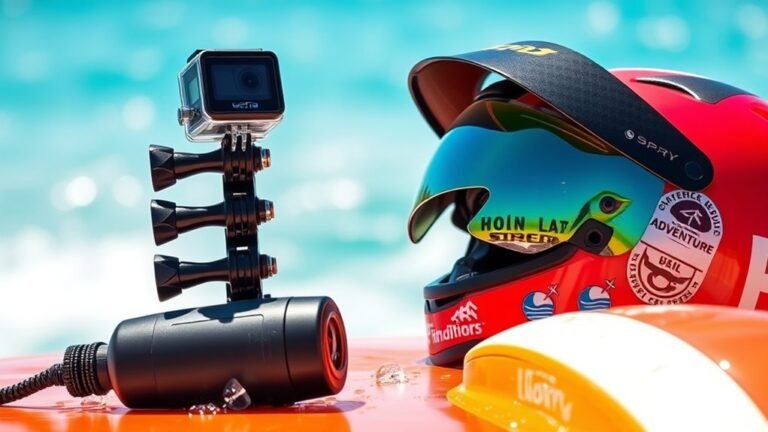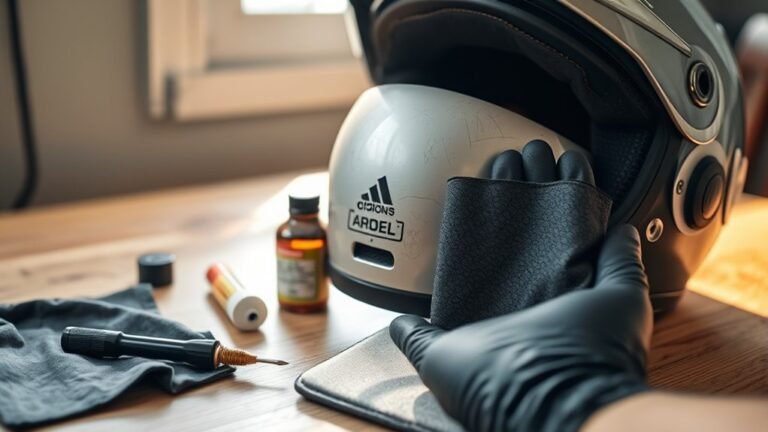How to Store Your Water Sports Helmet Properly
To store your water sports helmet properly, first clean it thoroughly to remove any salt, sand, or stains. Make certain it’s completely dry by air drying it in a well-ventilated area, away from direct sunlight. Choose a shaded location, avoiding extreme temperatures, and store it in a padded, water-resistant helmet bag to protect it. Regularly inspect your helmet for damage and wear. You’ll find additional tips on maintenance and care to keep your helmet in top condition.
Clean Your Helmet Before Storage
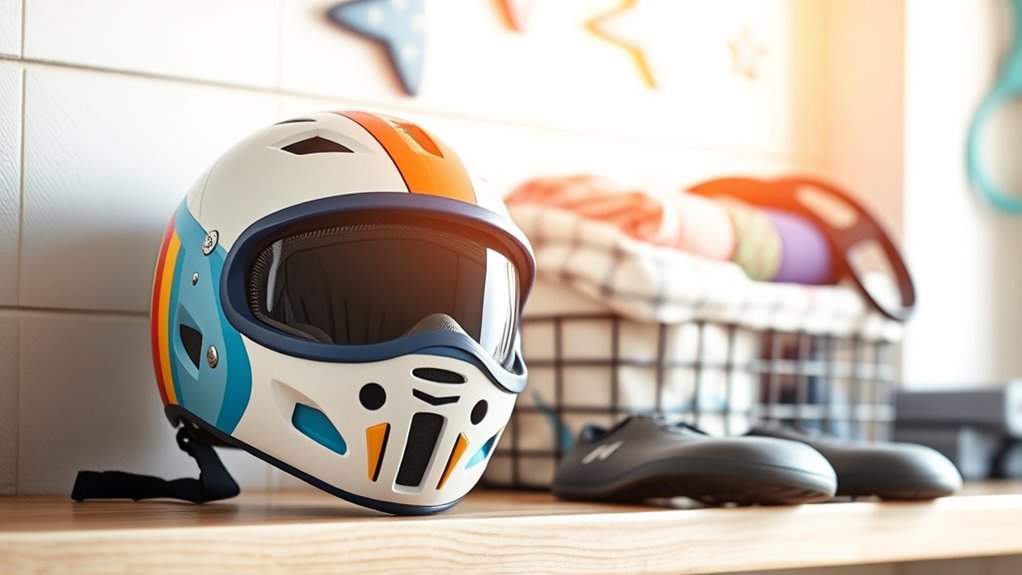
Before you tuck away your water sports helmet, it’s essential to give it a thorough cleaning. Start by using effective cleaning techniques, such as rinsing the helmet with fresh water to remove salt, sand, or debris. For stubborn stains, a gentle soap solution works wonders; just avoid harsh chemicals that could damage the material. Next, focus on disinfecting methods to guarantee it’s free from bacteria and odors. A mixture of water and vinegar can be a natural alternative for disinfection. Wipe down all surfaces, including straps and padding, making sure to get into any crevices. Once you’ve cleaned and disinfected, let it dry completely before storage. This way, you’ll keep your helmet in peak condition for your next adventure.
Ensure Proper Drying
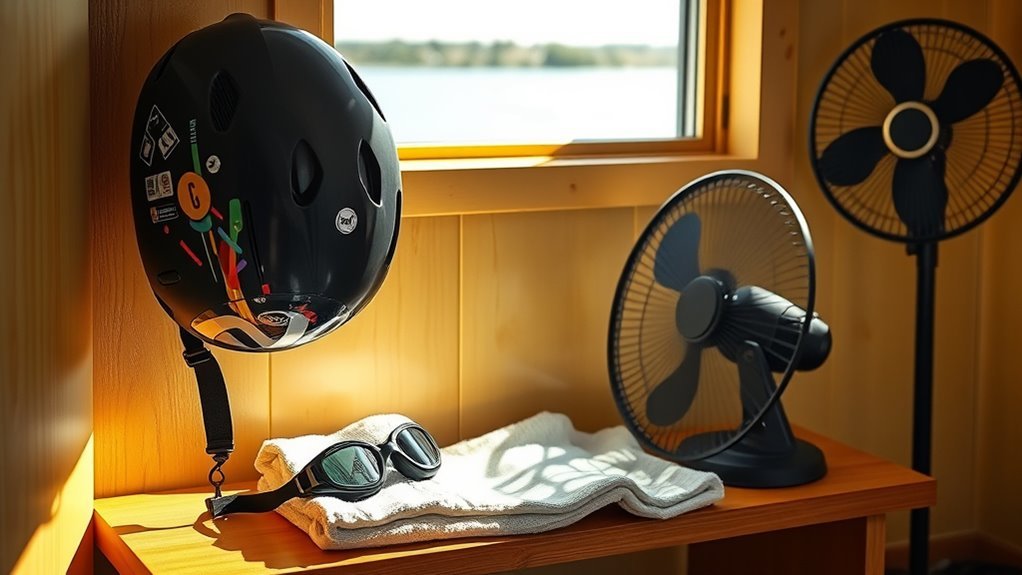
After cleaning your helmet, it’s essential to guarantee it dries completely. Always air dry it in a well-ventilated area and steer clear of direct sunlight, which can damage the materials. Proper drying not only maintains the helmet’s integrity but also prevents mold and odor buildup.
Air Dry Completely
To guarantee your water sports helmet remains in top condition, it’s essential to air dry it completely after each use. Start by removing any liners or padding, allowing for better air circulation. Hang your helmet upside down in a well-ventilated area to facilitate effective moisture control. Avoid enclosed spaces where humidity can linger, as this can lead to mold and unpleasant odors. Ascertain there’s ample airflow around the helmet, so every nook dries thoroughly. If possible, use a fan to speed up the process. Remember, a dry helmet not only lasts longer but also keeps you safe and comfortable during your adventures. Prioritize drying your gear, and enjoy the freedom of the water worry-free!
Avoid Direct Sunlight
While ensuring your helmet is completely dry, it’s important to keep it out of direct sunlight. UV damage can greatly reduce your helmet’s lifespan, compromising its effectiveness when you need it most. To protect your gear, follow these tips:
- Store your helmet in a shaded area.
- Use a helmet bag that blocks UV rays.
- Avoid leaving it in your car, especially on sunny days.
- Clean and dry it indoors to minimize sun exposure.
Store in Ventilated Area
Proper drying is essential for your water sports helmet, and storing it in a ventilated area can make all the difference. Without proper ventilation, moisture can build up, leading to unpleasant odors and potential damage. Choose a space that allows air to flow freely around your helmet to guarantee it dries completely after each use.
| Pros of Proper Ventilation | Cons of Poor Ventilation |
|---|---|
| Reduces odor | Promotes mold growth |
| Extends helmet lifespan | Deteriorates materials |
| Keeps padding fresh | Causes discomfort |
| Maintains safety standards | Decreases performance |
| Enhances comfort | Increases replacement costs |
Choose the Right Storage Location
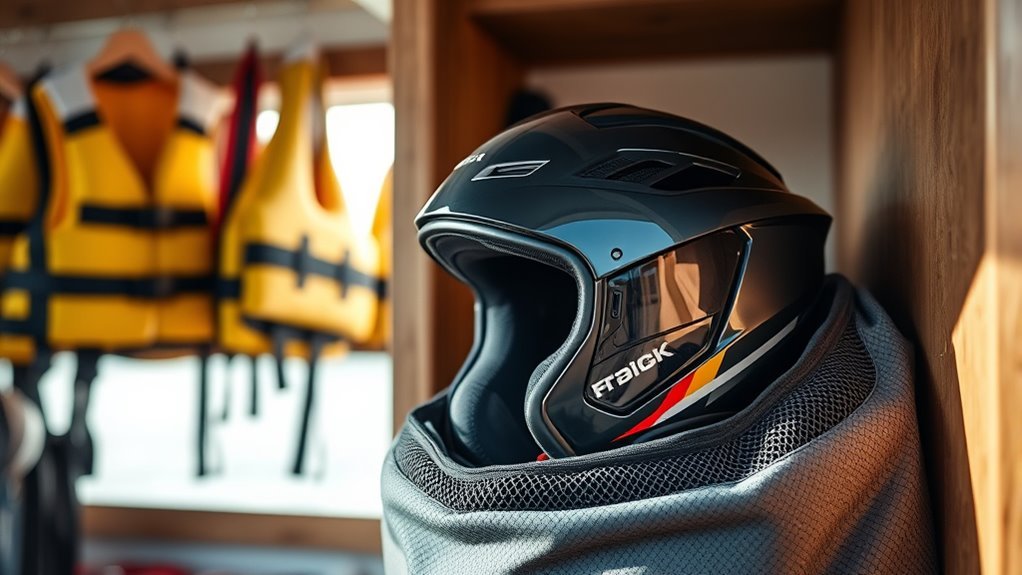
Choosing the right storage location for your water sports helmet is essential for maintaining its integrity and longevity. When selecting a spot, consider these key location factors:
- Temperature: Avoid areas with extreme heat or cold; both can damage your helmet.
- Humidity: Steer clear of damp places, as moisture can promote mold and degrade materials.
- Exposure to Sunlight: Keep it out of direct sunlight to prevent fading and weakening of the helmet’s structure.
- Safety from Impact: Store it in a secure area where it won’t be accidentally knocked or stepped on.
Use a Helmet Bag or Case
Using a helmet bag or case is essential for protecting your water sports helmet. Make certain to choose one made from durable materials that can withstand moisture and impact. Additionally, guarantee the bag or case fits your helmet snugly to prevent any movement that could lead to damage.
Choose the Right Material
When it comes to protecting your water sports helmet, the right storage material makes all the difference. Choosing a helmet bag or case with suitable helmet materials can enhance durability factors and guarantee your gear stays in top shape. Here are four essential aspects to take into account:
- Material Quality: Opt for high-quality fabrics that resist wear and tear.
- Padding: Look for bags or cases with adequate padding to absorb shocks.
- Water Resistance: Confirm the material is water-resistant to protect against moisture.
- Ventilation: Choose options with breathable fabrics to prevent mold and odors.
Ensure Proper Fit
A helmet bag or case not only protects your water sports helmet but also guarantees it fits securely during storage. Proper fit is essential, as it helps maintain helmet sizing and assures peak performance when you’re out on the water. Make sure to take fit adjustments into account while storing; this can prevent deformities over time.
| Helmet Size | Fit Adjustments | Recommended Bag/Case |
|---|---|---|
| Small | Padding | Compact Bag |
| Medium | Straps | Versatile Case |
| Large | Inserts | Sturdy Bag |
| Extra Large | Custom Fit | Adjustable Case |
Avoid Extreme Temperatures
To guarantee your water sports helmet remains in prime condition, it’s important to avoid exposing it to extreme temperatures. Temperature extremes can damage the materials, leading to reduced performance and safety. To keep your helmet safe, follow these guidelines:
- Store it in a climate-controlled environment, away from heaters or air conditioners.
- Avoid leaving it in your car during hot or cold weather.
- Don’t expose it to direct heat sources, like campfires or radiators.
- Regularly check for warping or other damage caused by temperature fluctuations.
Store Away From Direct Sunlight
Direct exposure to sunlight can greatly degrade your water sports helmet over time. Sun exposure leads to UV damage, which weakens the materials and diminishes the helmet’s protective capabilities. To guarantee your helmet stays in peak condition, store it in a cool, shaded area, away from windows and direct light. A dedicated storage bag or box can be beneficial, providing an additional layer of protection. By keeping your helmet out of the sun’s harsh rays, you not only prolong its lifespan but also maintain the freedom it provides during your water adventures. Remember, a well-cared-for helmet enhances your safety as you chase waves, so give it the protection it deserves by avoiding sun exposure.
Regularly Inspect Your Helmet
Keeping your helmet out of direct sunlight is just one part of maintaining it. Regular inspections are essential for guaranteeing your safety on the water. Here are some helmet maintenance tips to follow:
- Check for Cracks: Look for any visible damage that could compromise safety.
- Inspect Padding: Verify the padding is intact and clean; replace if necessary.
- Examine Straps: Make certain straps are secure and free from fraying.
- Test Fit: Your helmet should fit snugly without being uncomfortable.
Regular inspections highlight the safety gear importance for your water sports adventures. By staying proactive, you’ll prolong your helmet’s life and make sure it’s ready when you seek that next thrill!
Frequently Asked Questions
How Often Should I Replace My Water Sports Helmet?
You should replace your water sports helmet every 3 to 5 years, depending on usage and conditions. Helmets have a finite lifespan, and exposure to sun, saltwater, and impacts can degrade materials over time. Even if it looks fine, you can’t always see hidden damage. Regularly inspect your helmet for cracks or wear and prioritize safety above all. Staying informed about replacement frequency will keep you protected and enjoying your time on the water.
Can I Store My Helmet in a Damp Area?
You shouldn’t store your helmet in a damp area. Damp storage can lead to mold and mildew, compromising the helmet’s integrity and safety. For proper helmet maintenance, always keep it in a cool, dry place, away from direct sunlight. This not only extends its lifespan but also guarantees you’re safe while enjoying your water sports. Remember, a well-maintained helmet is essential for your adventures on the water.
What Materials Are Best for Helmet Storage Bags?
For storing your helmet, nylon bags and padded cases are your best options. Nylon bags are lightweight, durable, and resistant to moisture, making them great for on-the-go protection. Padded cases, on the other hand, offer extra cushioning, safeguarding your helmet from impacts and scratches. Both materials help maintain your helmet’s integrity, ensuring it’s ready for your next adventure. Choose what fits your needs, and your helmet will thank you!
Is It Safe to Stack Helmets During Storage?
It’s generally not safe to stack helmets during storage. Stacking can compromise helmet safety, as the weight of one helmet can deform the foam or outer shell of another. This might reduce their effectiveness in a crash or impact situation. Instead, consider storing each helmet separately in a designated area to maintain their shape and protective qualities. Proper care guarantees you’re ready for your next water adventure without risking safety.
How Can I Tell if My Helmet Is Damaged?
To tell if your helmet’s damaged, take a moment for a thorough inspection. Look for cracks, dents, or signs of wear, like frayed straps or faded padding. If you spot any of these issues, it’s time to contemplate a replacement. Remember, your helmet protects your freedom on the water. Don’t ignore helmet inspection tips; ensuring your gear’s in top shape means you can enjoy your adventures without worry. Safety’s always worth it!
